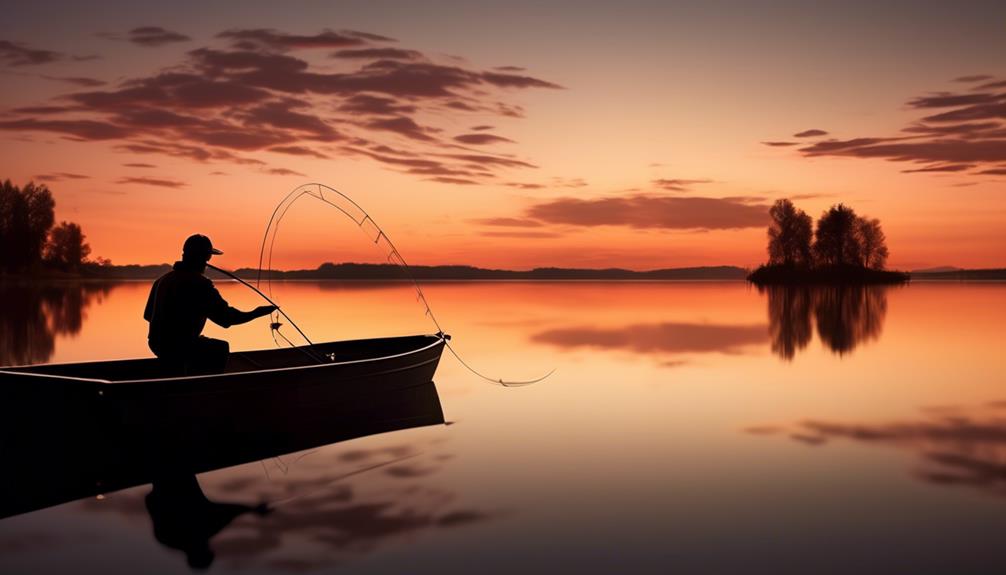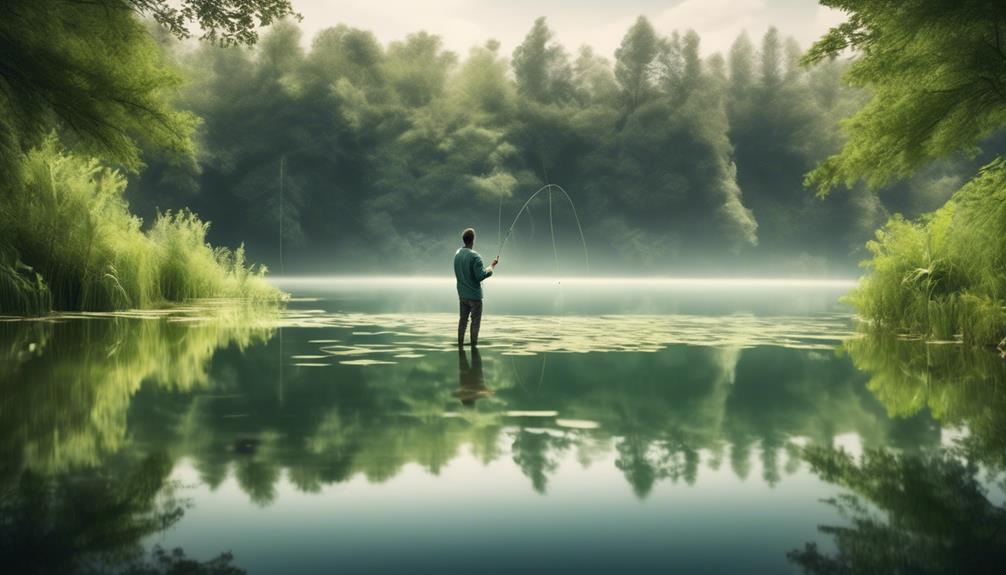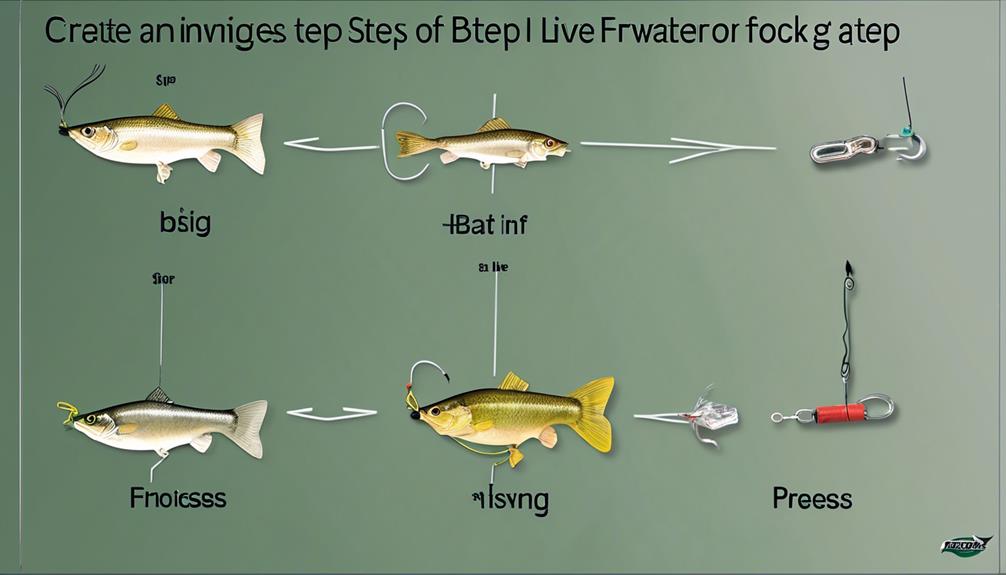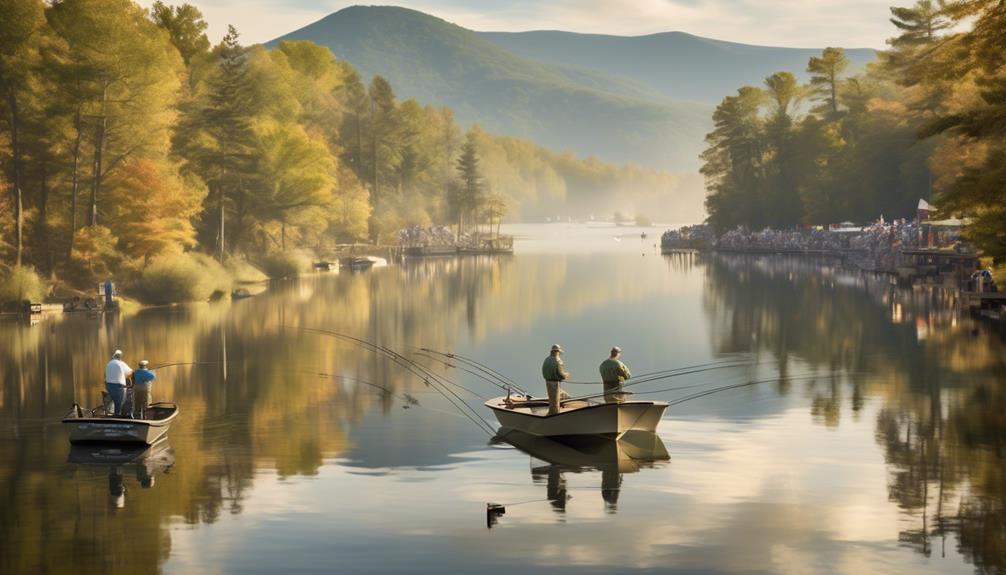Have you ever wondered why many anglers claim that dawn and dusk are the best times for freshwater fishing? Is there any truth to this widely held belief?
As you prepare for your next fishing trip, you may find yourself pondering this question. Well, the answer might surprise you. There are several factors that make dawn and dusk optimal for catching freshwater fish, and understanding them could significantly improve your chances of landing a big catch.
The Importance of Dawn and Dusk
To maximize your chances of a successful freshwater fishing outing, prioritizing the periods of dawn and dusk is crucial. These times are when natural light has a significant impact on fish activity. During dawn and dusk, the changing light triggers biological rhythms in fish, signaling that it's time to feed. This makes these periods optimal feeding times, as fish are actively searching for food to replenish their energy levels after a night of rest and before the upcoming night.
As the sun rises during dawn, it brings a gradual increase in light, signaling to fish that it's time to start foraging for food. Similarly, during dusk, as the light begins to fade, fish become more active in their pursuit of prey. The changing light levels during these times directly influence fish behavior, making them more responsive to bait and lures.
Understanding the significance of dawn and dusk in freshwater fishing can greatly enhance your chances of a successful catch. By aligning your fishing trips with these optimal feeding times, you can capitalize on the heightened activity of fish, increasing the likelihood of bites.
Understanding Fish Behavior
Understanding fish behavior is essential for freshwater anglers, as it directly impacts their success in catching fish during prime feeding times such as dawn and dusk. To effectively understand fish behavior, consider the following key factors:
- Feeding Patterns: Fish are more active during dawn and dusk due to their feeding patterns. At these times, they tend to feed more aggressively, making it an opportune moment for anglers to capitalize on their heightened activity. Factors such as water temperature play a crucial role in influencing fish feeding behaviors, as warmer water temperatures often lead to increased metabolism and feeding activity.
- Water Temperature: Understanding the relationship between water temperature and fish behavior is crucial. Fish tend to be more active and feed more actively in water temperatures that are within their preferred range. Therefore, being aware of the temperature preferences of various fish species can greatly enhance a fisherman's chances of success during dawn and dusk.
- Predator-Prey Dynamics: Recognizing the dynamics between predators and prey is essential for predicting fish behavior. During prime feeding times, predatory fish are often on the prowl, seeking out their prey. Understanding these dynamics can help anglers strategically target areas where predator-prey interactions are likely to occur.
- Habitat Preferences: Different fish species have distinct habitat preferences, which influence their behavior. Understanding these preferences allows anglers to identify prime locations for fishing during dawn and dusk, increasing their chances of a successful catch.
Ideal Weather Conditions
During dawn and dusk freshwater fishing, favorable weather conditions play a crucial role in determining your potential success. Clear, calm weather during these times of day is ideal for fishing. It allows you to utilize a wider range of lures and baits effectively. On the other hand, windy conditions can make casting difficult and cause your bait or lures to be less effective.
Additionally, water temperature is a key factor to consider. During dawn and dusk, the water temperature is typically cooler, which can stimulate fish activity. Warmer water holds less oxygen, so during hot weather, fish may be less active and stay in deeper, cooler parts of the water. Therefore, cooler temperatures during dawn and dusk can lead to more active fish and increased chances of a successful catch.
When it comes to selecting your fishing equipment, the weather conditions should dictate your choices. For example, in windy conditions, heavier lures and sinkers may be necessary to ensure they reach the desired depth. In contrast, during calm weather, lighter lures and baits can be used more effectively. Being mindful of the weather and water temperature allows you to adapt your fishing techniques and equipment to optimize your chances of a successful catch during dawn and dusk.
Choosing the Right Bait
When considering the favorable weather conditions for dawn and dusk freshwater fishing, your choice of bait becomes essential for increasing your chances of a successful catch. Bait selection plays a crucial role in attracting fish during these prime times.
To maximize your fishing success, consider the following tips for choosing the right bait:
- Know the Fish Species: Different fish species have distinct preferences when it comes to bait. Research the specific types of fish that inhabit the freshwater body where you plan to fish during dawn and dusk. Understanding their feeding habits will help you select the most enticing bait.
- Consider Lure Options: While natural baits like worms and minnows are often effective, don't overlook artificial lures. Lure options vary widely, from spinners and spoons to soft plastic baits. Experiment with different lures to see which ones align with the fish preferences in your chosen fishing spot.
- Match the Hatch: If there's a particular insect or aquatic creature hatching during dawn or dusk, try to mimic it with your bait. Fish are more likely to respond to bait that resembles the natural food sources available to them at that time.
- Adjust Based on Conditions: Pay attention to the environmental conditions such as water clarity, temperature, and current. These factors can influence fish behavior and, consequently, their response to different types of bait. Adapt your bait selection based on the prevailing conditions to optimize your chances of a successful catch.
Techniques for Dawn and Dusk
To optimize your chances of a successful catch during dawn and dusk freshwater fishing, mastering effective techniques is crucial. Lighting conditions play a significant role during these times, and understanding how to adjust your casting techniques accordingly is essential. As the light changes, fish become more active, and this is the time to capitalize on their increased movement.
To make the most of the low light, consider using lures that create strong contrasts, such as dark-colored lures against a dim sky or light-colored lures against a darkening backdrop. This will help catch the attention of the fish in the changing light conditions.
When it comes to casting techniques, precision is key. The low light during dawn and dusk can make it challenging to accurately gauge distance and direction. Practice casting before these times, and consider using baitcasting reels for better control. Utilizing navigation tips can also enhance your fishing experience during these periods. It's important to familiarize yourself with the area you'll be fishing in, especially if you'll be on a boat. Knowing the layout of the water and potential obstacles will allow you to navigate safely in the changing light conditions.
Understanding fish movement is crucial for successful dawn and dusk fishing. Fish tend to move closer to the shore during these times to feed, so targeting areas near the shoreline can increase your chances of a catch. By incorporating these techniques, you can significantly improve your freshwater fishing experience during dawn and dusk.
Locating Prime Fishing Spots
Exploring the shoreline and observing underwater structures can help pinpoint prime fishing spots for dawn and dusk freshwater fishing. When seeking the best spots to fish during these times, consider the following:
- Casting Accuracy: Pay attention to the shoreline and any overhanging trees or bushes. These areas often provide cover for fish and can be hotspots for catching them during dawn and dusk. Casting accuracy is crucial in these areas, as a precise cast close to the cover increases your chances of enticing a bite.
- Water Depth: Different fish species prefer different water depths. During dawn and dusk, predatory fish often move into shallower waters to feed, while others may be more active in deeper areas. By observing the water depth and any changes in depth along the shoreline, you can identify potential feeding grounds and locate the best spots to target specific fish species.
- Fish Movement: Understanding the movement patterns of fish in the area is essential for locating prime fishing spots. During dawn and dusk, fish tend to move closer to the shore to feed. Look for signs of fish movement such as ripples on the water's surface or the presence of baitfish, which can indicate the presence of larger predatory fish.
- Feeding Patterns: As the day transitions into night or vice versa, fish are often more active as they prepare for periods of low light. Observing feeding patterns of fish during these times can help you identify where they're congregating to feed, allowing you to position yourself strategically for a successful fishing session.
Safety Precautions to Consider

While fishing at dawn and dusk, prioritize safety by being mindful of potential hazards and taking necessary precautions to ensure a successful and secure fishing experience.
Begin by conducting an equipment checklist before heading out. Make sure to have all the essential gear, including a life jacket, first aid kit, flashlight, communication device, and any other safety equipment required by local regulations. It's crucial to inspect your fishing gear as well, ensuring that it's in good working condition to prevent any accidents or malfunctions while on the water.
Emergency protocols should also be a top priority. Familiarize yourself with the location's emergency procedures and contacts, such as the nearest medical facilities and emergency services. Additionally, inform someone about your fishing plans, including your expected return time and location. This ensures that someone knows where you're in case of an emergency. It's also advisable to carry a personal locator beacon or have access to a mobile phone with a waterproof case for communication in case of unforeseen circumstances.
Lastly, always be aware of your surroundings and weather conditions. Keep an eye on the changing weather patterns and be prepared to head back to shore if a storm approaches. Remember to stay hydrated, protect yourself from the sun, and watch out for any wildlife that may pose a threat.
Other Factors to Keep in Mind
As you continue your freshwater fishing excursion during dawn and dusk, it's crucial to keep in mind other factors that can significantly impact your overall experience and success.
Here are some other important factors to consider:
- Water Temperature
The temperature of the water can greatly affect the behavior of fish. Warmer water tends to increase fish activity, while colder water may slow them down. Understanding the water temperature can help you determine the best fishing spots and the most suitable bait to use.
- Ambient Light
The amount of light present in the environment can influence fish behavior. During dawn and dusk, the changing light conditions can trigger feeding behaviors in fish. Pay attention to how the ambient light changes and adjust your fishing techniques accordingly.
- Weather Patterns
Weather plays a significant role in freshwater fishing. Changes in weather can affect fish movements and feeding habits. Keep an eye on weather forecasts and plan your fishing trips accordingly.
- Underwater Structure
Understanding the underwater structure of the fishing location is essential. Fish often seek shelter and food around underwater structures such as rocks, vegetation, and drop-offs. Knowing the underwater terrain can help you locate potential hotspots for fishing.
Considering these factors alongside the prime fishing times of dawn and dusk can greatly enhance your freshwater fishing experience and improve your chances of a successful catch.
Frequently Asked Questions
How Can I Best Prepare for a Dawn or Dusk Fishing Trip?
To prepare for a dawn or dusk fishing trip, you should choose the right tackle and bait. Consider weather conditions and find the optimal location. Be ready for prime fishing times with the right gear and strategy.
Are There Any Specific Regulations or Restrictions for Fishing During These Times?
During dawn and dusk, fishing regulations may include time restrictions to protect fish populations. Conservation efforts focus on minimizing environmental impact. Check local laws for specific rules, such as catch limits and designated fishing areas during these prime times.
What Are Some Common Mistakes to Avoid When Fishing at Dawn or Dusk?
When fishing at dawn or dusk, avoid common mistakes like using noisy equipment, casting too close to the shore, and not adjusting to changing light conditions. Practice proper techniques by using the right lures and staying patient.
Are There Any Specific Types of Fish That Are More Commonly Caught During These Times?
During dawn and dusk, specific types of fish like bass, trout, and walleye are commonly caught. Use fishing techniques like topwater lures and ideal bait such as live bait or artificial lures for successful freshwater fishing at these times.
How Can I Maximize My Chances of Catching Fish During Dawn and Dusk?
To maximize your chances of catching fish during dawn and dusk, use fishing techniques like casting near cover and using topwater lures. Pay attention to weather conditions, as fish are more active in low light and during changing weather patterns.
Conclusion
So, next time you plan a freshwater fishing trip, make sure to schedule it during dawn or dusk for the best chance of catching some big ones.
Remember to consider the weather conditions, choose the right bait, and use the appropriate techniques.
And always prioritize safety while enjoying your fishing experience.
With these tips in mind, you're sure to have a successful and enjoyable time on the water.
Happy fishing!



